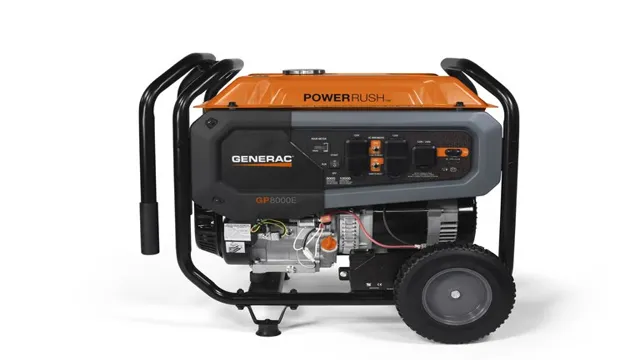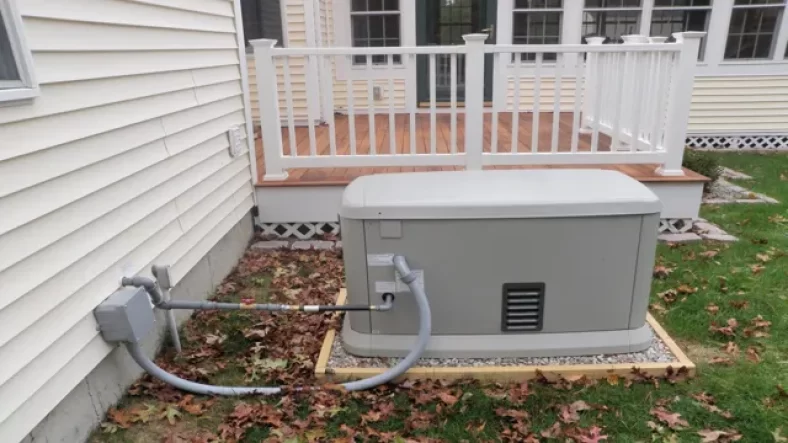Generac generators are an essential item for homeowners in areas where power outages are common. These machines are designed to provide electricity when the grid goes down, ensuring that you’re not left in the dark or without access to essential home appliances. But how do Generac generators work? In this blog, we will be exploring the inner workings of these powerful machines, getting to know what makes them tick and how they function to provide reliable backup power.
Whether you’re a seasoned pro or a complete beginner, this guide will provide you with essential insights into one of the most important devices in your home. So, buckle up and get ready to dive deep into the fascinating world of Generac generators.
The Basics
If you’re wondering how a Generac generator actually runs, it’s pretty simple. It’s powered by natural gas or liquid propane, which are both fed into the generator through a fuel line. Once the fuel enters the generator, the engine uses a spark to ignite it, which creates the energy that powers the machine.
This energy is then transferred from the generator to the electrical panel, which distributes the power to your home or business. The generator is designed to automatically turn on when there is a power outage, ensuring that you always have electricity available. In addition, most Generac generators are equipped with a built-in transfer switch, which ensures a smooth transition from your utility power to generator power.
Overall, Generac generators offer reliable and efficient power solutions, making them a popular choice for homeowners and businesses alike.
Fuel Source and Engine Start
When it comes to starting a car engine, the fuel source plays a vital role. Most modern cars run on gasoline, but there are also diesel, electric, hybrid, and alternative fuel vehicles available. Gasoline engines use spark plugs to ignite the fuel in the combustion chamber, while diesel engines rely on compression to ignite the fuel.
Electric motors use rechargeable batteries to power the car, while hybrid engines combine gasoline power with electric power. Ultimately, the type of fuel source you choose for your car will depend on your personal preferences and driving needs. When it comes to starting any type of engine, it’s important to follow the manufacturer’s instructions and give the engine time to warm up before driving.
This will ensure optimal performance and longevity of your vehicle.

Fuel Injection and Combustion
Fuel injection and combustion are two critical components of a vehicle’s engine system. Fuel injection allows for precise amounts of fuel to be delivered to the engine’s cylinders at the perfect time for optimal performance. This process provides greater fuel efficiency and reduces the number of harmful emissions that come out of the exhaust.
Combustion is the process that converts the fuel and air mixture into energy, which powers the engine and allows the vehicle to move forward. When the right amount of fuel is combined with air and ignited in the combustion chamber, it leads to a controlled explosion that provides the energy required to move the vehicle forward. This process is reliant on a variety of factors such as timing, airflow, fuel pressure, and temperature.
If any of these factors are off, it can lead to issues such as decreased power, poor fuel economy, or even engine failure. Overall, fuel injection and combustion work together to ensure the engine operates efficiently and safely.
The Power Transfer
If you’re wondering how a Generac generator runs, it’s all about the power transfer. Essentially, the generator’s engine runs on fuel, which then converts the mechanical energy into electrical energy through a process called electromagnetic induction. This energy is then transferred through a device called an alternator, which regulates the voltage and frequency to produce the correct amount and type of electricity needed to power your home or business.
Generac generators also have automatic transfer switches, which detect when there is a power outage and automatically switch to generator power, ensuring that your power stays on even during an outage. The system is designed to be reliable and efficient, providing dependable power that can keep you going through even the toughest situations. So, how does a Generac run? It’s all in the power transfer, and with the right setup, it can run smoothly and reliably for years.
Power Output and Voltage Adjustment
Power output and voltage adjustment are two crucial aspects that determine the efficiency and effectiveness of any electronic device. Power transfer refers to the amount of energy that is transmitted from the source to the destination. In simple terms, a device with high power output can transfer more energy and vice versa.
Voltage adjustment, on the other hand, relates to the amount of voltage required for the device to function optimally. A device’s voltage rating is an essential parameter that needs careful consideration during installation. Therefore, it is crucial to ensure that the power output and voltage adjustment are correctly configured to ensure optimal performance of your device.
Failure to do so might cause your device to overheat or malfunction, leading to severe damages. Hence, always ensure that the power output and voltage adjustment are adequately balanced to ensure seamless functioning.
Sensors and Automatic Shutdown
When it comes to power transfer, sensors and automatic shutdown systems play a crucial role in making the process efficient and safe. These sensors can detect any anomalies or issues in the system and send signals to the automatic shutdown systems to prevent any accidents or further damage. Imagine a car engine that shuts down its fuel pump when there is a problem with the oil pressure; similarly, power systems can be shut down automatically when there is any abnormality detected by the sensors.
The power transfer process is like a relay race where one runner passes the baton to the other, and any slip-up can lead to a disaster. Hence, using sensors and automatic shutdown systems in power transfer ensures reliable and safe transmission of power.
Automatic Transfer Switch
An automatic transfer switch (ATS) is an essential component in most backup power systems. It works by monitoring the power supply from the grid, and in the event of an outage, automatically switches over to a backup power source, such as a generator or battery. This allows for uninterrupted power supply to critical appliances, systems, and devices that require a constant and reliable power supply.
One of the major benefits of an ATS is its ability to detect and switch over to backup power within seconds of detecting an outage. This is especially important for businesses, data centers, and hospitals where even a momentary loss of power could have catastrophic consequences. Another key advantage of an ATS is that it helps to minimize downtime and disruptions.
Regular power outages, even for short periods, can be extremely disruptive and costly for businesses and industries. By automatically switching over to backup power, an ATS helps to ensure that critical systems continue to function, reducing the risk of financial loss and operational disruptions. Overall, an ATS is an indispensable component of any backup power system.
Whether it’s for residential or commercial purposes, an ATS provides a reliable and efficient solution to ensure uninterrupted power supply in the event of an outage. If you’re considering a backup power system, make sure to include an ATS as part of the setup to ensure complete peace of mind.
Maintenance Tips
When it comes to Generac generators, many people wonder how they run and what it takes to keep them running at their best. These strong, reliable machines operate using either natural gas or propane fuel sources and utilize an internal combustion engine to create electricity. In order to ensure optimal performance, regular maintenance of your Generac generator is key.
This includes regular oil changes, air filter replacement, and overall inspection for any signs of wear or damage. It is also important to keep the fuel source topped off and free of debris, as a clogged fuel line or tank can cause major problems. By taking care of your Generac generator and providing it with the proper maintenance, you can enjoy reliable power when you need it most.
Oil and Filter Changes
Oil and filter changes are essential maintenance tasks for any vehicle owner. Not only do regular oil changes help keep your engine running smoothly, but they also improve fuel efficiency and extend the life of your engine. A general rule of thumb is to have your oil and filter changed every 5,000 to 7,500 miles, but it is best to consult your owner’s manual or a professional mechanic for specific recommendations based on your make and model of car.
Changing your oil and filter is a relatively simple process that can be done at home with the right tools and some basic knowledge, but it is important to follow proper disposal methods for the used oil and filter. By making oil and filter changes a priority in your vehicle’s maintenance routine, you can ensure that your car remains in top condition for years to come.
Fuel Quality and Storage
When it comes to maintaining fuel quality and storage, keeping the fuel tank clean is essential. Regular cleaning of the fuel tank helps prevent the accumulation of dirt and debris that can clog the fuel filters, thereby hampering the smooth functioning of the engine. Additionally, it’s vital to use quality fuel stabilizers to ensure that the fuel remains stable and does not degrade over time.
Proper fuel storage also involves storing fuel in a cool and dry place, away from direct sunlight or heat sources. This helps prevent fuel evaporation and oxidation, which can lead to the formation of varnish and gum deposits. A great analogy for fuel storage is to think of it like storing food – proper storage helps prevent spoilage, while improper storage can lead to contamination and spoilage.
By following these maintenance tips, you can ensure that your stored fuel remains of high quality and lasts for a longer period of time.
Conclusion
So there you have it, folks. The Generac runs on a cunning combination of fuel, air, and electricity. This tripartite power alliance kicks into gear at the slightest hint of a power outage or load shedding, delivering reliable and uninterrupted energy to keep your home or business humming.
It’s a marvel of modern engineering and a testament to the ingenuity of humanity. In summary, to keep your lights on through thick and thin, just remember that where there’s Generac, there’s power!”
FAQs
What type of fuel does a Generac generator run on?
Generac generators primarily run on natural gas or liquid propane, but they can also be fueled by diesel or gasoline.
How does a Generac generator start automatically during a power outage?
Generac generators are equipped with an automatic transfer switch that senses when there is a power outage and turns on the generator to provide backup power.
How long can a Generac generator run on a full tank of fuel?
The runtime of a Generac generator on a full tank of fuel will depend on the size and model of the generator, as well as the type of fuel being used. However, most Generac generators can run for several hours to several days on a full tank of fuel.
How often should I perform maintenance on my Generac generator?
Generac recommends performing maintenance on their generators every 6 months or after 100 hours of use, whichever comes first. This includes changing the oil, air filter, spark plugs, and performing other routine checks to ensure the generator is in good working condition.


